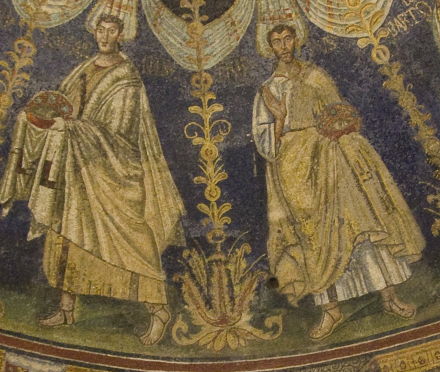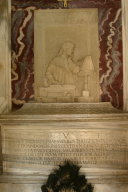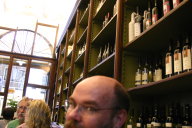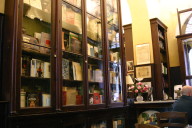
|
| Oh those mosaics! |





|
| Oh those mosaics! |
|
One of our main aims in visiting northern Italy was to get to Ravenna, which is not always on the itinerary of someone doing the abbreviated modern version of the Grand Tour.
Mark has mentioned how Guy Gavriel Kay’s book “Sailing to Sarantium” made him want to see Ravenna. I had read of the mosaics there many years earlier, but I confess that I too decided on the basis of the fantasy novel that it would be wonderful to see the town. Mark had discovered at the internet café that we should leave from Venice Santa Lucia at about 10:45, getting to Ferrara around noon, and we could pick up a local to Ravenna arriving in Ravenna around 2:30. This we did, getting a little snack in Ferrara and discovering outside the station there an immense number of parked bikes, which I think Mark pulled a snapshot of. In both Ferrara and Ravenna, bikes seem to be a popular mode of transport. Certainly we saw lots of folks in Ravenna going about their ordinary business on bicycle.
|
|
|
We made our way first to the biggest thrill in Ravenna, the Basilica of San Vitale. It’s not called a basilica because of its shape, which is just an octagonal drum, but for some ecclesiastical reason that I don’t understand. You get the feeling while standing in it that it’s higher than it is wide; of course my photographs can’t help you judge that. The mosaics were more beautiful than I ever imagined, showing a lot of stylistic variation in the portraits of the saints. There are actual portraits there, of the Emperor and of the Bishop who commissioned the church, but I don’t think that I have snaps of any of these latter.
Fortunately there was plenty of light for me to take time-exposures, by resting the camera against a pillar. In many of the pictures, this pillar shows up. No way to avoid that, I think. Not all the beauty was on the walls and ceilings: as you see in two pictures at the left, the floors were very lovely as well.
|
|
The next stop was the Battistero Neoniano, called in English the Baptistery of Neon, which is correct, but looks awfully funny when you write it down. It’s the Orthodox (Catholic) baptistery, as opposed to the Arian one, which we unfortunately didn’t get to. At any rate, this is the oldest monument in Ravenna, and I’ve used details of this here and there as samples of the beauties of Ravenna. Now, a couple of weeks later and 10000 kilometers away, I’m wondering why I took only three pictures here. Maybe I was just still reeling from San Vitale, which is rather more spectacular. And perhaps it was just that the eyebones were getting tired, but I also took far too few pictures in the Basilica of Sant’ Apollinare Nuovo as well. This was originally an Arian church, built by Theodoric the Great, but was reconsecrated as a Catholic church in 561, only 35 years after Theodoric's death. Below are two of the most interesting pictures I took there:
The left-hand picture shows a bunch of saints in a row—if you look at the big image, you can see which one is which. Maybe not so easy to see in the small image. I find it interesting that the saints are identified just by name, rather than by iconographic details: no arrows for Saint Sebastian, for instance. You probably recognize that the row of saints is what I’ve used for the background of these pages. In the right-hand picture (large image small), the three kings wearing their Persian trousers are bringing their gifts to a Virgin and child who for some reason are enthroned in glory rather than roughing it amongst the domesticated animals. I guess I really should be avoiding flippancy here: these places are just about the oldest Christian churches I’m likely to get into and admire, or you, either: even Hagia Sofia in Istanbul isn’t as old as San Vitale, and that one hasn’t been a church for 500 years. |
|

We really did want to get to see Dante’s tomb: the story is that he was banished from Florence, so could be buried only here in Ravenna. But in penance, Florence pays for the oil in the ever-burning lamp placed in the tomb. I don’t have a picture of the lamp, but Mark does on his page. My rather inadequate picture taken within the tomb is at the right (big image, small).
I suppose I should say that we went to the church where we knew we would find the tomb, and wandered around quite a bit wondering whether we had seen it without realizing. Finally we found it outside the church, and it was very satisfying indeed.

|

|
Our return train left fairly late—around eight in the evening—so we had quite a bit of time to kill, though not enough that we could eat dinner there in Ravenna. But Mark had found an interesting enoteca mentioned in one of the guide books, a place called Ca’ de Vèn. We wandered about looking for it, and a very helpful Ravennese (if that’s what a native of Ravenna is called) with practically no English told us that we should really go to this typical place around the corner, named, of all things, Ca’ de Vèn. We waited a few minutes till it opened, and sat down to a wonderful and cheap (€3.50) glass of Sangiovese accompanied by little munchies, and relaxed and enjoyed the atmosphere.
The enoteca proper is fairly small and intimate, even with its high ceilings; but adjoining it is a restaurant that’s broadly open, with a two-story-high ceiling. I think it would have been nice to eat there. But where we were, there were books and bottles everywhere. You can see bottles in the upper picture to the left (big image, small), and some of the books in the lower picture (big image, small).
Not much more to report for this day: we got to the railroad station in plenty of time for our Toonerville Diesel to Ferrara, and were back in Venice in time for an unpretentious but overpriced meal at another restaurant by the Grand Canal. To bed by midnight—next day was nothing but travel, through the Appenines to Florence, so next page describes the day after that.
Pictures from the day after next; from the previous day. Return to the central Italy page; to the central travel page; to my home page.